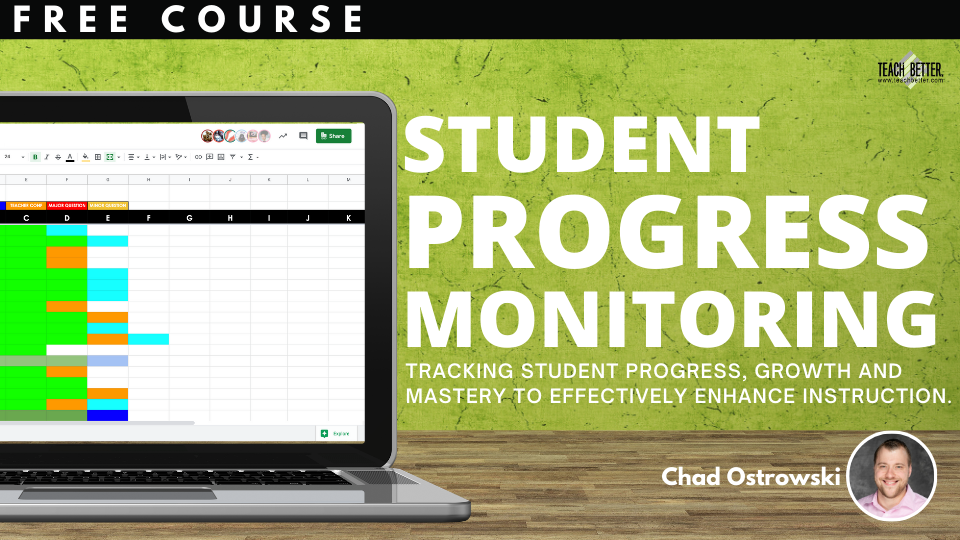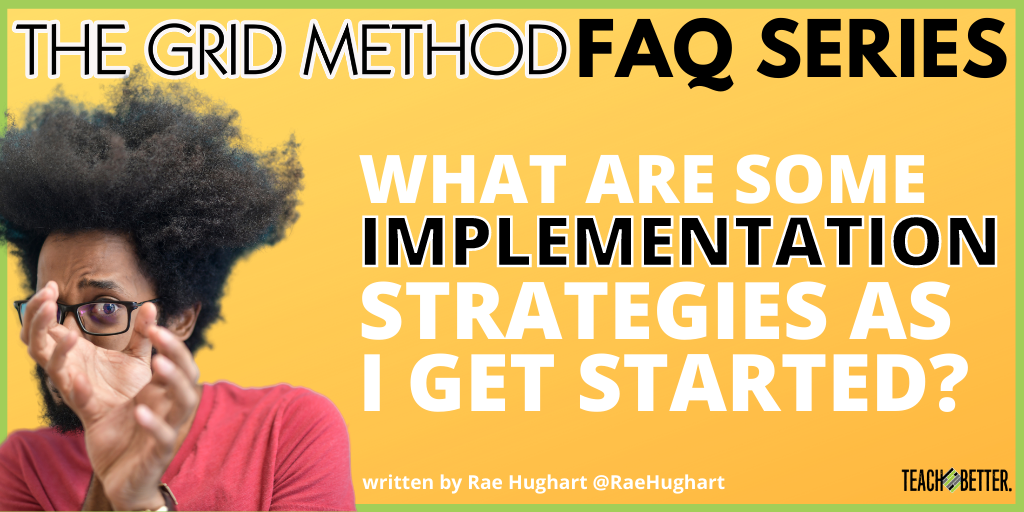TL;DR:
- Some implementation strategies for The Grid Method include starting small and having a supportive network of colleagues to lean on.
- Allow students and stakeholders time to process this shift in your classroom and allow opportunities for them to provide feedback.
With any new idea in the classroom, we must think through all of the details. Sometimes I feel like a classroom is as complex as a space shuttle launch—every button and lever we adjust affects twelve other things. Yikes!
For those with a sensitive stomach, this leads to many educators not feeling comfortable taking the plunge into the unknown. But for those with a little bit of bravery and a large dose of dedication to continual reflection and problem-solving, this shift can be career-changing.
When I was originally introduced to the idea of mastery learning, I thought it was a great idea—but it would never work in my classroom.
The idea of giving students the autonomy to learn and grow on their own terms while I took the role of facilitator seemed like a fantasy. My students would never be okay with that. My students wouldn’t care enough to work through their learning unless I was standing over them forcing them to do the work. They just want to have me tell them the plans and work until the bell. This intrinsic motivation model may work with other “fun” subjects like art or music. But hey, I am only a math teacher. Who actually ever wants to learn math?
Oh, how foolish I was.
My students not only thrived while being able to control their learning pathway, but would never allow me to take that control back from them.
About 4 months into using a mastery approach in the classroom, I had about a week or so to plan before a major holiday break. I just figured during this week I would plan to not use a Grid and provide students some instruction as a full class with activities to complete throughout the class time. It was only 4-5 days…what’s the worst that could happen?
Oh gosh, friends, I GOT SO MUCH PUSH BACK FROM STUDENTS! Originally I was baffled. Why were they so upset? However, as I reflected on their perspective, I was sending a strange message. One week I wanted them to take control of their learning, demand the right to learn, question everything, reflect, and work harder then they had before to master content.
Then, the next week, I was asking them to sit quietly, take notes, listen to me talk, and then do the activity I assigned. Why? Because I said so and that was the activity for the day. I have totally stripped the students of their right to control their learning—and they revolted. Rightfully so (hehe).
Now do not get me wrong, I often take days away from the Grid throughout the year. However, my approach to doing this is now very different. Now I take the time to explain this shift to students and we work together as a team to understand the plans. I’m also much more aware of providing students opportunities for voice and choice regardless of the learning assignment. This ensures students still carry the autonomy to take hold of their learning and run with their ideas!
I'm also much more aware of providing students opportunities for voice and choice regardless of the learning assignment. This ensures students still carry the autonomy to take hold of their learning and run with their ideas! Click To TweetNeedless to say, implementation is a process. So, let’s review some essential implementation strategies to consider as you are getting started with a mastery learning framework into your classroom.
Implementation strategies: Don’t bite off more than you can chew.
Anytime we make a shift, it can be overwhelming. So don’t bite off more than you can chew. You can always take more on later! I have had endless conversations with teachers eager to do The Grid Method, who in later conversations feel the need to apologize they haven’t started implementation yet. Stop feeling shame! Any mastery learning shift is a big deal! There is nothing wrong with starting small.
Maybe begin first with some of the classroom management elements of a Grid, like the Triage System or a Progress Monitoring System (check out the course on this topic in the Teach Better Academy). Then maybe layer on your first Grid with some very strict elements. Then, as you go, slowly let go of that control.
For me, the first step was using growth mindset language that focused on the student’s level of understanding rather than task completion.
Implementation strategies: Collect your coaches & cheerleaders.
Having a supportive network to brainstorm ideas, celebrate the wins, and complain about the hurdles is essential! Therefore, as you begin your implementation, do not be a stranger to the Teach Better Family! You want to keep your cheerleaders and coaches close. This could mean setting a recurring Calendar event to attend the Bi-Weekly Family Check-In held within the Teach Better Team Private Facebook Group to ask questions and brainstorm solutions with a member of the team. Or consider setting up time with a Teach Better Team member to get one-on-one brainstorming through a roadblock you are currently battling. Just reach out in a direct message or email!
[scroll down to keep reading]
Implementation strategies: Allow students & stakeholders to process.
Isn’t it scary when we start something new? We as teachers want to do so well, we become emotionally invested in a project and worry that involving students and stakeholders opens the floodgates of criticism. What if they ask a question that I don’t know the answer to?!? Anyone? Bueller?
I facilitated a webinar through the Teach Better Team this summer on this very idea: introducing families and students to a progressive classroom. There was one major take away from our webinar I hope to leave here for you:
You have dedicated so much time chewing on the idea of mastery learning, daydreaming, problem-solving, and wrestling with this idea. Your students and stakeholders need to be provided the same grace.
They need to sit with the idea, ask questions, and reflect. The trick is doing this without allowing it to break your confidence!
You have completely reenvisioned a learning space that puts students first, focuses on growth and understanding, and transitions your role from the “content delivery system” to the “facilitator of learning”…and that’s all-new! New for you, for families, and for students. So be prepared…it’s going to feel odd, you are going to encounter roadblocks, and you will get questions about this shift.
You know shifting your classroom from a “teacher-focused” environment to a “student-focused” learning space is best for student success and growth. You CAN do it!
We will find greater success long term if we can shift our mindset away from being criticized and toward giving suggestions to make our work EVEN Better. AND, when we provide a space for other voices to be heard, stakeholder and student “buy-in” increases.
So, start small with multiple conversations with students and a quarterly survey to stakeholders. And if feedback is something you are hungry for, incorporate feedback continually! You could even include it within your Grid!
For me, I often invite families into my classroom (either virtually or physically) to see what we are up to! The best way to create an understanding of the classroom is to see it in action! You have incredible things going on in your classroom. Allow others to come in and see the magic.
Impact Story
When I first started using The Grid Method in my classroom, I didn’t imagine the impact it could have. I started to notice that students were taking a stake in their education. They were making choices to show up and engage. They started asking more questions. MY STUDENTS were asking questions—not only to me but to one another!
I never imagined that The Grid Method would create a sense of community. I hear the excitement when students enter my class. Most get right to work because THEY KNOW where they are at with the content. And THEY KNOW where they are at with their knowledge on the content. The best testament to the awesomeness of The Grid Method is that many of my past students walk into my current classroom and still comment on how the switch to Grids was a game-changer for them. They tell my current students that they are so lucky to be in my class. – Candace Miller, Science Teacher at Briggs H.S. (Columbus City Schools)
About Rae Hughart
Rae Hughart is a Middle-Level Math Educator in Illinois, the Director of Training and Development for the Teach Better Team, and author of Teachers Deserve It (20) and Teach Better (19) books available on Amazon or Barnes & Noble. In 2017, Rae was honored with the Illinois State University Outstanding Young Alumni Award – inducting her into the University Hall of Fame. In 2018, Rae was honored again by winning 1st place in the Henry Ford Innovator Award for her work within educators communities to build unity between local businesses and schools. You can learn more about Rae or book her for Professional Development opportunities within the Teach Better Speakers Network.



